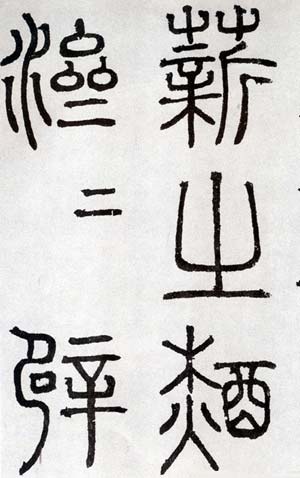Tao Zongyi (1329-?1421) was a calligrapher in Yunjian (now Songjiang, Shanghai) in the late Yuan Dynasty. His courtesy name was Jiucheng and his name was Nancun. A native of Qingyang, Huangyan (now part of Luqiao, Huangyan, Zhejiang). Literary historian in the late Yuan and early Ming dynasties. At the age of 20, he left home to take the exam. He failed because of his outspoken opinions on government affairs. He settled in Songjiang and made his living by opening a school to teach and cultivating fields. He refused four royal calls from the Yuan and Ming dynasties and never entered the official career. He was known as "Mr. Nancun" , known as "a person who is pure in character, always loyal to Yu, and a man of true justice in the world."
Tao Zongyi often went to the fields to farm in his spare time when he was teaching. During the break, I talked with the students about the past and the present. Whenever I got something, I recorded it on the leaves and stored it in an urn. In 10 years, I accumulated dozens of urns. In the twenty-sixth year of Zhizheng (1366), Tao Zongyi organized it into 30 volumes of "Zhuigeng Lu". Most of what is recorded in "Zhuigeng Lu" is historical anecdotes, mainly from the Yuan Dynasty, followed by the Song Dynasty, and a few historical materials from previous dynasties. It contains a large amount of what Tao Zongyi saw and heard, either excerpted from previous historical materials or used for research and falsification, such as Yuan Dynasty canons, opera poems, historical miscellaneous records, culture and technology, customs and folk sentiments, peasant uprising records, etc., which are preserved for future generations. rich historical data. "Zhuigenglu" also records the historical data of Huangyan.
As a famous historian and litterateur in Chinese history, Tao Zongyi did not seek fame and wealth throughout his life, and was poor in teaching. He only took pleasure in writing books. In addition to "The Record of Shuing Geng", he also wrote "The Record of Shuing Geng", which collected epigraphic inscriptions and studied the theory and history of calligraphy. He compiled 9 volumes of "Shu Shi Hui Yao", which collected 617 works by famous writers from the Wei and Han Dynasties to the Song and Yuan Dynasties; compiled 100 volumes of "Shuo Yong", which is an important private collection of large-scale books; he also wrote 4 volumes of "Anthology of Nancun Poems", 2 volumes of "Four Books", as well as "Leiyuan of the Ancient Tang Dynasty", "Cao Mang Private Journey", "Continuation of Travel Chronicles", "Ancient Carvings of Congchao", "Yuanshi Ye Ting Ji", "Jin Dan Mi Yu", "Cang Lang" "湣歌", "Guofeng Zunjing", "Chunhua Tie Kao", etc.
Tao Zongyi was a scholar and calligrapher. Generally, dictionaries list him as a calligrapher in the Ming Dynasty. However, his main activities were in the Yuan Dynasty, so he should be listed as a calligrapher in the late Yuan Dynasty. He has many works, among which "The Record of Shuing Geng" is the most famous, and "The History of Calligraphy" is well-known among those who govern calligraphy. He interacted with a group of literati such as Yang Weizhen and had a keen eye for calligraphy and painting. His "Picture of Fishing Boats in the Autumn Forest on Ma Wan" is written in official script, but it has a unique style. The pen used is mainly square pen folding knife method, and square pens are used at every turning point to show the angle and strength. The word "knot" is also square. These all show the influence of Wei and Jin official scripts. The horizontal paintings do not use graceful and gentle waves, but are drawn outward with fine strokes, so they have a decorative taste. Although the whole article is well-proportioned, neat and rigorous, it is still full of ancient meaning. This shows that Tao Zongyi wanted to transform the ancient into the new and create a unique style. There are also some new features in his seal script books: first, the center pen and the square pen are combined. The lines of his seal script are partly the round and straight lines of the jade chopsticks, mixed with the angular lines of the square pen, so there are pauses and folds in the circles, giving an ancient flavor; secondly, the structure of the seal script changes the single shape of the small seal script. The structure of the top is tight and the bottom is loose. Not all of them are square, but sometimes they are knotted with small seal script and bell and tripod characters. There is something original in the form. Tao Zongyi sought innovation and change in the retro trend of thought, showing an incredible spirit of exploration.

Seal script part








